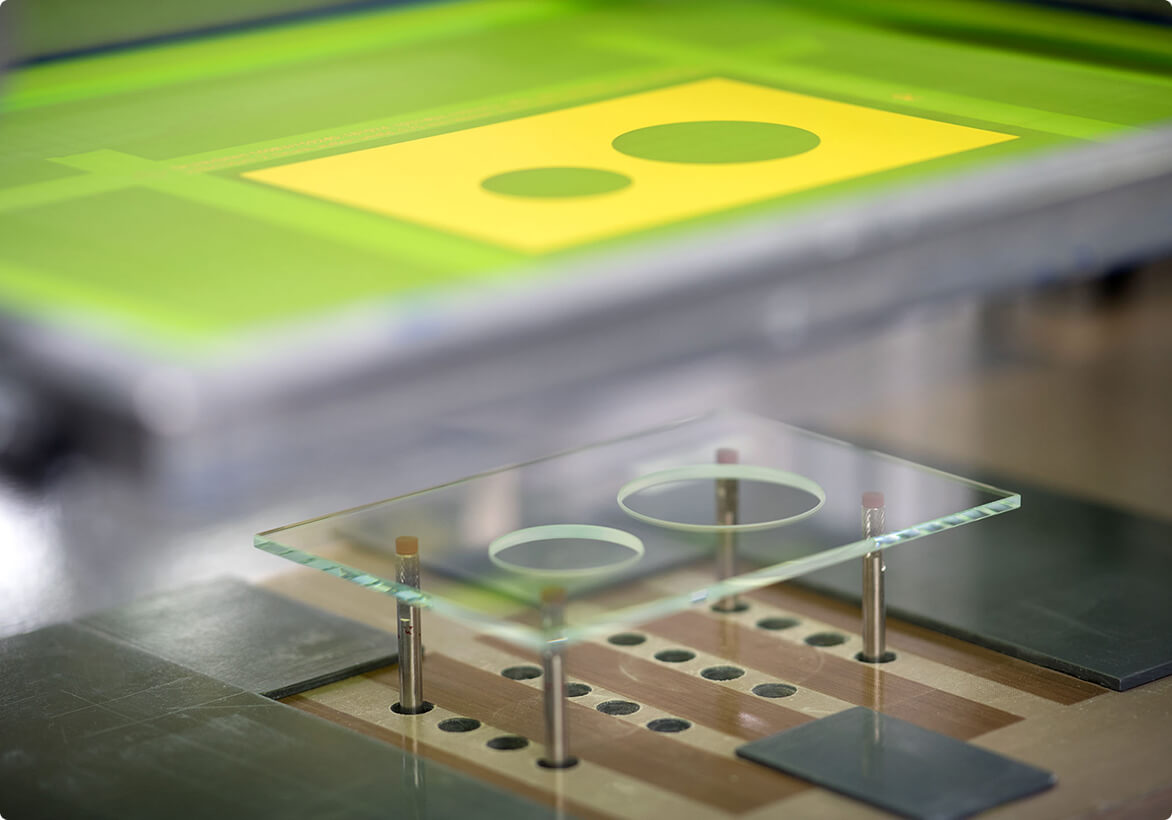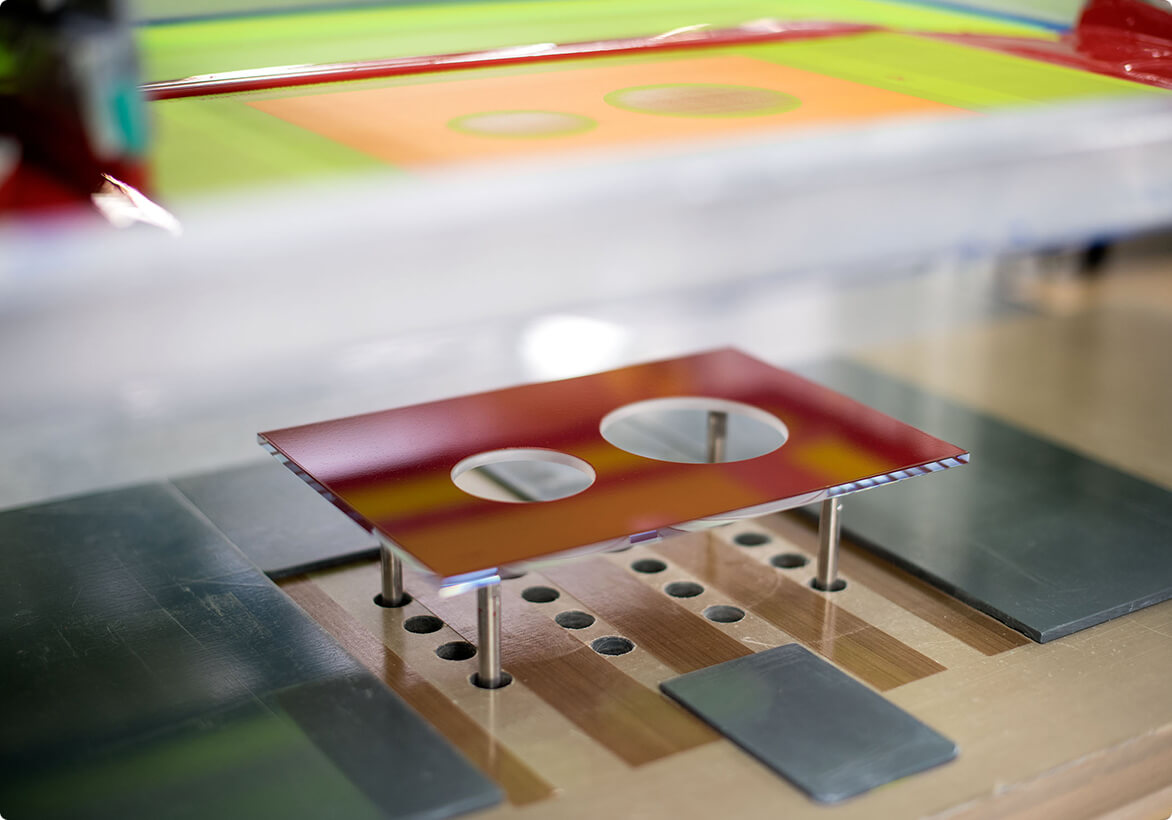
Screen printing & ceramic digital printing on glass
We have been able to apply colour-accurate logos, UV-resistant designs or perfectly legible technical screen printing to glass for over 30 years. We produce high-resolution prints, e.g. for electronic circuits, with our systems in a clean room. In this way, we guarantee the highest quality. Also for all subsequent processes.
Silkscreen printing on glass

Screen printing process in a clean room
With our cleanroom screen printing process and the high degree of automation, we can produce prints with an accuracy of up to 80 µm. By linking our screen printing lines with the automated delivery of glass substrates, our processes are very efficient and enable us to print large quantities of series products with consistent quality.

Small-sized glass printing
Precise positioning by hand is required for the multiple paint applications to produce our glass buttons. The printed symbols on the individual keys are only visible when they are backlit. We achieve this through a specific sequence of colors and a glaze print, which makes the symbols released in the print disappear from the eye.

Large format glass printing
We also print large-format glasses with ceramic inks according to the requirements of our customers. Our color system consists of ceramic inks, which are baked into the glass after printing. As a result, the printed glass is simultaneously hardened and refined into ESG (single-pane safety glass).
Screen printing for high
design requirements

We process flat glass into tempered glass (ESG) for use in sanitary technology, for example. In doing so, we meet the highest requirements for the quality of the colors and the cleanliness of the surfaces and edges. The picture shows a glass toilet plate immediately before the paint is applied.

One of the main advantages of ceramic screen printing is, among other things, the high opacity of the colors and their durability after baking. The colors are mixed by our experts in our in-house color laboratory according to customer specifications and applied using screen printing.
Ceramic digital print

Glass printing for outdoor use
Digital printing with ceramic colors on glass and other materials is commonplace for us and is particularly useful when a wide variety of colors with additional gradients is to be printed, or a prototype is needed quickly as a sample. Due to the high durability of the baking colors, the printed glasses are ideal for outdoor use, for example as an alternative for signage, as a privacy screen or for façade design. An interesting option for architects would be to design insulated glass with pictures for facades, for example.

Printing on glass for individual designs
With our digital printing options, almost all customer requirements for designing indoor and outdoor glass surfaces can be met. UV-resistant 4-color graphics or photo prints up to a format of 2,500 x 1600 mm in different glass thicknesses can be easily produced and can usually be delivered by us directly from the factory. Another advantage of the digital printing process is that no special colors have to be mixed, as our process involves 6-channel color printing (CMYKGW).

Printing on glass for small quantities
Custom designs or samples are easily possible with our digital printing, depending on your needs. Compared to screen printing, this process is a cost-effective option, since printing does not require the production of the screens required for screen printing.
Ask us directly, we look forward to hearing your ideas.
FAQ
Worin unterscheiden sich keramischer Digitaldruck und Siebdruck auf Glas?
- Siebdruck: eignet sich für vollflächige oder wiederholende Muster, Schichtstärken >10 µm, hohe Deckkraft, hohe Kantenschärfe. Ideal für großvolumige Serien.
- Digitaldruck: arbeitet berührungslos mit keramischen Tinten (organische Binder +Glasfritten), ermöglicht fotorealistische Motive, variable Daten, hohe Flexibilität bei Kleinserien und Individualisierung
Wie wird die Haftung und Beständigkeit des keramischen Drucks auf Glas gewährleistet?
Der Druck muss bei ca. 600–700 °C während des Vorspannprozesses in die Glasoberfläche eingebrannt werden. Dabei schmilzt die Glasfritte in der Tinte an und verbindet sich dauerhaft mit der Glasoberfläche. Das Ergebnis ist kratzfest, UV-stabil, chemikalien-, temperatur- und witterungsbeständig.
Welche Anforderungen gelten an das Glas vor dem keramischen Druck?
- Glas muss gereinigt und entfettet sein (keine Silikon- oder Staubrückstände).
- ESG oder VSG sind möglich, Druck erfolgt vor dem Vorspannprozess.
- Flachheitstoleranzen sind zu beachten, da Unebenheiten Druckqualität und Schichtdicke beeinflussen.
Welche Einschränkungen bestehen bei keramischem Siebdruck und Digitaldruck?
- Siebdruck: begrenzte Auflösung (~100–150 dpi), Farbwechsel erfordern separate Siebe, hoher Rüstaufwand bei Kleinstserien.
- Digitaldruck: limitierte Schichtstärke (Deckkraft oft geringer als beim Siebdruck),Farbtreue abhängig von Kalibrierung, Glasfarbe/Transluzenz kann das Ergebnisbeeinflussen.
Gibt es normative Vorgaben für keramisch bedrucktes Glas?
Ja, maßgeblich sind u. a.
- DIN EN 12150 (ESG), DIN EN 14449 (VSG) für Sicherheitsglas mit keramischem Druck,
- EN ISO 2591 / ASTM C1048 für Qualitäts- und Prüfanforderungen,
- nationale Bauordnungen, die Druckschichten als Bestandteil der Glasoberfläche behandeln (z. B. Beständigkeit gegen Bewitterung).
Welche industriellen Einsatzbereiche sind typisch?
- Architektur: Fassadengestaltung, Sonnenschutz, Sichtschutz, Corporate Design.
- Automotive: Bedruckte Fahrzeugscheiben, Bedienelemente.
- Innenausbau: Design- und Funktionsglas (Küchenrückwände, Trennwände, Möbelglas).
- Technisch: Eingabesysteme (HMIs), Leiterbahnen, Markierungen und Funktionsschichten.

